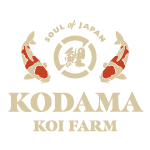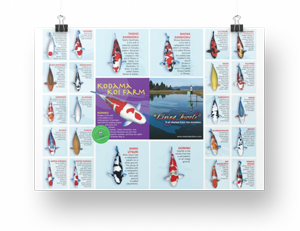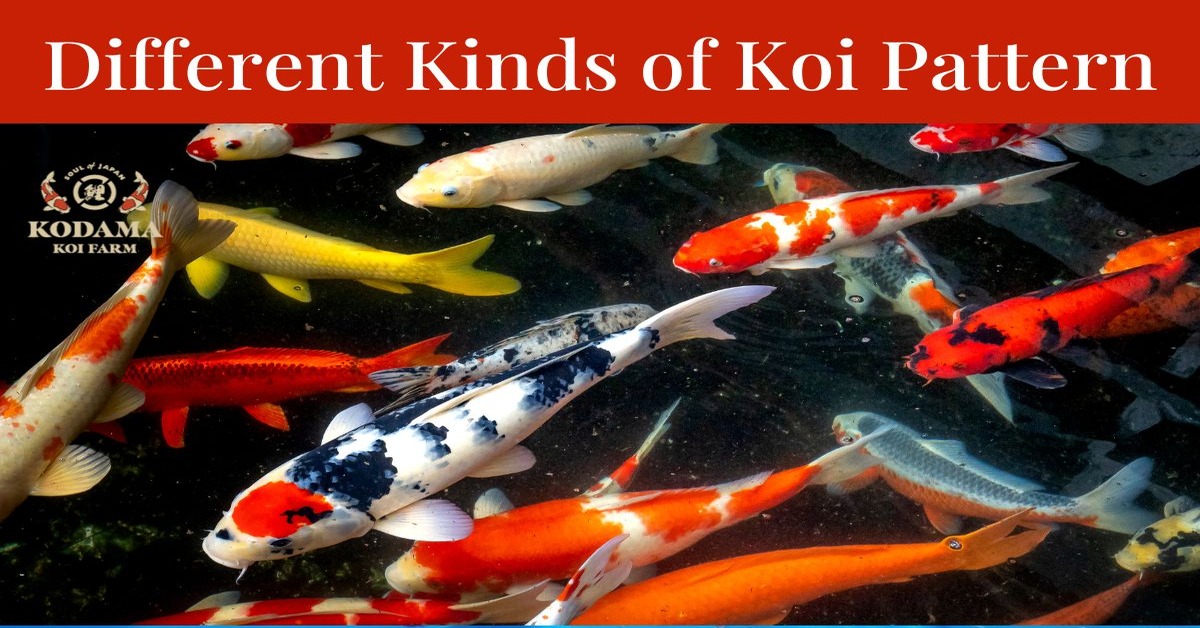
Well-known koi patterns include Kohaku, which features bold red markings on a white base, Sanke (white with red and black), and Showa (a black-based koi with red and white markings). Other classifications focus on the placement of these patterns. For example, Tancho koi have a single, round red spot on the head, while Gin Rin refers to koi with glittering, reflective scales. Each of these patterns contributes to the incredible diversity of koi fish, making them a true living art form.
In this article, we will explore these koi pattern classifications in greater detail, helping hobbyists and collectors deepen their understanding of what makes each koi variety unique and highly valued in the world of Nishikigoi.
Topics We Will Cover About Koi Patterns
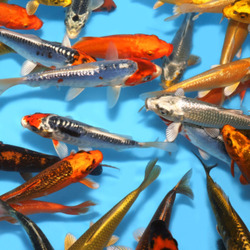
5 Most Common Koi Fish Patterns & Markings
Koi markings hold deep significance in Japanese culture, with each term representing the fish’s unique beauty and characteristics. Below are some of the most recognized patterns and their corresponding varieties:
Hi Pattern
Hi Pattern refers to the red markings (Hi) on a koi fish’s body, which vary in shape, size, and distribution. These patterns play a critical role in koi classification and significantly influence a fish’s aesthetic value.
Common patterns include Maruten, characterized by a crown-like spot on the head, and Tancho, distinguished by a single red spot on the head. Another example is the Sandan (three-step pattern), featuring three distinct red markings over the body.
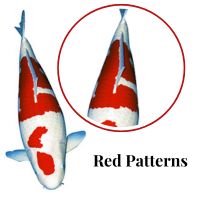
Building upon the variety of Hi patterns, let’s explore how they manifest in specific koi varieties:
- Kohaku are a classic koi variety with red (Hi) patterns over a white body. They belong to the Hi pattern category because their defining feature is the vibrant red markings.
- Sanke (Taisho Sanshoku) are white koi with red (Hi) and black (Sumi) markings. They belong to the Hi pattern category because their red markings are a primary feature alongside black accents.
- Showa (Showa Sanshoku) are black-based koi with red (Hi) and white (Shiroji) markings. They belong to the Hi pattern category because their red markings are a key element of their tri-color pattern.
Sumi Pattern
Sumi Pattern refers to the black (Sumi) markings on a koi fish, varying in shape, size, and placement.
Sumi enhances contrast and balance in varieties like Sanke and Showa. Quality Sumi appears deep, lacquer-like, and strategically positioned to create harmony with the koi’s Hi (red) and Shiroji (white) patterns.
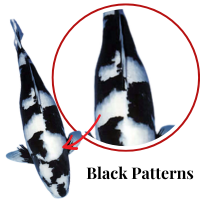
Here’s an example of how Sumi patterns manifest in different Koi Fish varieties:
- Shiro Utsuri are black-based koi with white (Shiroji) markings. They belong to the Sumi pattern category because their bold black (Sumi) markings define their appearance, creating striking contrast against the white.
- Bekko are koi with a base color of white, yellow, or red, featuring black (Sumi) spots. They belong to the Sumi pattern category due to the black markings contrasting with their base color.
- Ki Utsuri are yellow-based koi with black (Sumi) markings. They belong to the Sumi pattern category because the black Sumi contrasts against the bright yellow, creating a striking, balanced appearance.
Amime (Netting) Pattern
Amime (Netting) Pattern refers to a delicate, mesh-like pattern of fine black lines on a koi’s skin, resembling a net.
This pattern typically appears on white or light-colored koi, adding texture and visual interest. It enhances the koi’s overall aesthetic and is especially sought after in certain varieties like Shiro Utsuri.
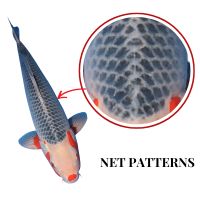
Here’s an example of how the Amime (Netting) Pattern appears in various Koi fish varieties:
- Asagi Koi are koi with a light blue or grayish-blue body and red markings. They belong to the Amime (netting) pattern category due to their characteristic net-like, fine black lines over the blue body.
Ai (Indigo Netting on Koromo) Pattern
Ai Pattern refers to the indigo-blue netting (Ai) seen on Koromo koi, typically over red (Hi) markings. This distinctive net-like pattern adds depth and texture to the fish’s appearance.
The Ai pattern contrasts beautifully with the red and white elements, enhancing the overall visual appeal of Koromo varieties.
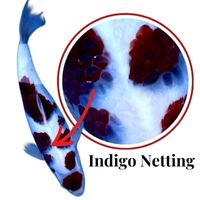
Here’s an example of koi how the Ai (indigo netting on Koromo) pattern is seen in different Koi fish varieties:
- Aigoromo are koi with a blue or indigo netting (Ai) over red (Hi) markings. They belong to the Ai pattern category because of the indigo-blue mesh effect on their body, enhancing contrast.
Shiroji Pattern
Shiroji Pattern refers to the white coloration on a koi’s body, which provides a clean, luminous backdrop for the fish’s markings.
Shiroji is a key feature in varieties like Kohaku, Sanke, and Showa, offering contrast to red (Hi) and black (Sumi) patterns, enhancing overall aesthetic harmony.
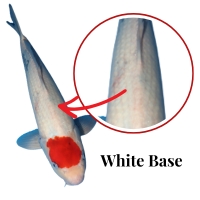
- Tancho are white-based koi with a single red (Hi) marking on the head. They are not typically in the Amime (Netting) pattern category, as they lack net-like scale patterns.
Maruten Koi Pattern Meaning
Maruten is a Japanese term used to describe a specific pattern on. A Maruten koi has a distinct red (hi) marking on its head, separate from the red markings on the rest of its body.
Watch this video about Maruten
- Maruten Kohaku: A white koi with a red spot on the head and additional red patterns on the body.
- Maruten Sanke: Similar to Maruten Kohaku but with black markings (sumi) added to the body.
- Maruten Showa: A koi with a Maruten pattern, complemented by a mix of black and red markings on a white body.
This distinct marking is prized for its symmetry and its ability to draw attention to the koi’s head, considered an essential feature in competitions.
A koi’s pattern is more than a visual trait; it’s a combination of carefully cultivated genetics, artistry, and natural beauty. Breeders strive to create koi with balanced, vibrant, and harmonious patterns that embody the characteristics of specific varieties.
- Symmetry – Balanced markings on both sides of the koi’s body.
- Color Depth – Intense and uniform coloration without fading.
- Pattern Flow – How the design complements the koi’s body shape.
- Shiroji – The purity of the white base, which serves as a canvas for other colors.
Understanding koi patterns requires familiarity with the terms used to describe them. Let’s dive into some of the most iconic patterns and what makes them unique.
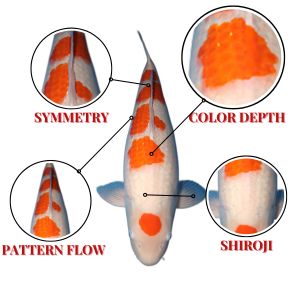
The Cultural Significance of Koi Patterns
In Japanese culture, koi patterns symbolize prosperity, perseverance, and beauty, with each fish’s unique markings often carrying auspicious meanings. These patterns blend natural elegance with cultural tradition, representing deeper connections to artistry and heritage.
Beyond their visual appeal, koi embody traits that resonate with people, making them a cherished symbol in ornamental ponds and gardens, where they inspire admiration and reflect timeless cultural values.
Classification of Koi Markings
Koi patterns are classified into several categories, each with its unique terminology and characteristics. Understanding these classifications is essential for hobbyists, collectors, breeders, and those participating in shows and contests.
Why Knowing Koi Markings Matters
- For Hobbyists: Identifying patterns enhances the enjoyment and appreciation of koi, allowing hobbyists to better understand and care for their fish.
- For Collectors: Recognizing markings aids in selecting koi with unique or rare patterns, increasing the value of their collection.
- For Breeders: Knowledge of markings helps breeders pair koi effectively to achieve desirable traits in offspring.
- For Shows and Contests: Markings play a critical role in judging koi. Understanding patterns can increase success in competitive environments.
Tips for Selecting Koi Based on Markings
Choosing the right koi can be a rewarding experience, especially when considering their markings. Whether for personal enjoyment, breeding, or competition, these tips will guide you in making the best choice:
| Pattern | Description |
|---|---|
| Color Depth | Color quality is essential; colors should be vibrant, uniform, and consistent throughout, with no fading, blemishes, or irregularities, ensuring a visually appealing and healthy koi that stands out in your pond. |
| Pattern Flow | Pattern placement is crucial; patterns should flow naturally, complementing the koi’s body shape and enhancing its overall visual appeal. A well-placed pattern creates a balanced and elegant look. |
| Shiroji | Shiroji purity is vital; ensure the white base is clean, bright, and unblemished, enhancing the contrast with other colors. A pristine white base makes the koi's colors stand out beautifully. |
| Personal Preference | Personal preference matters most; choose koi that bring you joy and align with your unique aesthetic. The right koi should resonate with your style and enhance your pond's beauty. |
| Symmetry | Symmetry is important when selecting koi, as balanced markings enhance their overall appearance. Pay close attention to the head and body for evenly distributed patterns. This creates a harmonious and visually appealing fish. |
The Importance of Body Conformation and Pattern in Competitions
When judging koi in competitions, several factors play a role beyond just their beauty. The body conformation is crucial, along with skin quality, color, and overall presence. Here’s a summary:
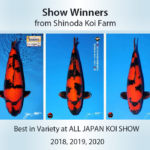
| Factor | Description |
|---|---|
| Kiwa | Characterized by sharp, clean edges at the boundaries of markings, kiwa is a key indicator of quality, ensuring patterns appear well-defined and visually striking. |
| Sashi | The slightly blurred leading edge of a pattern, sashi plays a crucial role in overall refinement. Good sashi maintains a parallel alignment to the kiwa, ideally extending no more than one scale width, contributing to a balanced and polished appearance. |
Koi Body Conformation
- Proportions: The body should have a smooth, torpedo shape, and fins must match body size.
- Head and Mouth: Head should be clean and appropriately sized, while the mouth must be well-shaped.
- Tail Tube: A strong tail tube indicates good genetics and growth potential.
- Symmetry: Both sides should mirror each other without deformities.
- Posture and Movement: The koi should swim gracefully; erratic movements can suggest health issues.
Other Judging Factors
- Skin Quality: High-quality koi have lustrous, almost translucent skin, essential for varieties like Kohaku.
- Color: Vibrant, consistent colors are vital. Reds should be deep, whites clean, and blacks rich.
- Pattern: Patterns should be balanced and flow naturally across the body, enhancing its shape.
- Size and Growth Potential: Larger koi often score higher, with growth potential assessed through genetics.
- Presence or Charisma: Some koi have an intangible “wow factor” that sets them apart.
- Health and Condition: Healthy koi with smooth skin and no visible issues score better.
Judges combine these factors to identify koi that exemplify the breed’s best traits, balancing aesthetics, genetics, and health.
Explore our collection of High-Quality Koi at Kodama Koi Farm and bring home a masterpiece today!
Types of Koi Fish Varieties Guide (PDF)
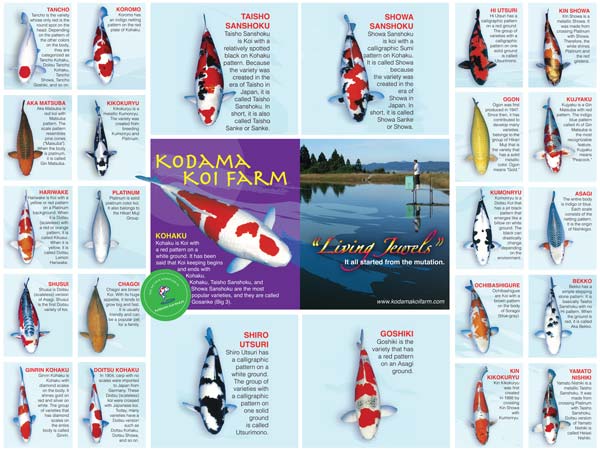
Download FREE Koi Variety Guide / Printable Poster:
Enter email to join our newsletter and receive koi variety guide printable file.
